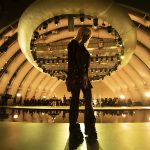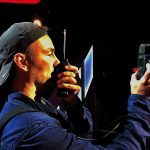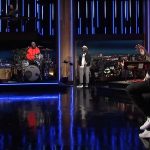Lighting for Comedy Specials Reflects the Star’s Distinctive Style
When Gabriel Iglesias sold out two nights in the Chicago area’s Allstate Arena May 20-21 for the filming of a Netflix special, lighting designer Robert Peterson knew he had a major challenge on his hands.
“Trying to maintain a personal connection between the artist and audience in that large a space was challenging,” he says. While he knew that Iglesias had a big enough personality to reach all the way to the back, Peterson had to achieve the right visual balance: getting some light on the entire audience for the cameras, but not so much that the crowd would become self-conscious — or worse, overshadow the performer.
“I lit them from the perimeter all the way around,” he says. “Everyone knew they were a participant, because they had a little raking backlight on them. Gabriel was able to grab everyone from the ringside seats all the way to the back of the arena. He then peppered in something I’d never seen before — he would start old jokes from his previous specials, and let the crowd finish them for him.” The resulting program will be released as a Netflix Original in 2016.
Peterson is one of a handful of designers across the country who specialize in lighting for solo comedy specials, combining an understanding of the requirements of a five or six-camera configuration with an ability to reflect the unique personality of the star in the show’s lighting design. “There’s a regional sensibility about it,” says Peterson, whose business is centered in Chicago. “If it’s in the heart of the country, I’ll most times get a call. But if you develop a personal relationship with the artist, location no longer matters.”

Northern California-based designer Michael Dalton, who has lit comedians including Katt Williams, Mike Epps, Jay Leno, The Godfathers of Comedy and Alex Reymundo, sees lighting for camera placement as the key to television comedy. “The average shoot is typically five to six cameras — two or three fixed positions, a house jib, a reverse camera, and maybe a handheld or Steadicam,” he explained. “Many of the best directors get the program record right during the live performance. Even so, you want to light it so that it can be edited easily.”
Dalton’s background includes a great deal of corporate work and concert lighting, which he says are more cue-intensive than a comedy special. “In a comedy show, there’s an audience and house look before the show starts, then the artist’s entry, which settles into a performance look,” he says. “For the Katt Williams American Hustle special, there was a sequence of automated lighting cues that were synced up with the audio and a reveal; then he entered and ran downstage center. After that, we had a base look and used spotlights, because he was very active and physical onstage.”
The secret, according to these designers, is the close-up — the shot that will dominate the screen for most of the show. Getting the look right involves color correcting and white-balancing the spotlights for the camera, says Dalton. “Typically, we don’t use any saturated colors — it’s CTO and a mix of standard color correction filters,” he says. “It’s about skin tone, contrast and balancing for the cameras.”

Spots in the Spotlight
Providing the best possible look for the camera can sometimes be tricky with comedy, because many comedians move all over the stage during their performance. Tom Beck, currently the lighting designer for Ellen: The Ellen Degeneres Show, whose work in comedy lighting has included Chris Rock, Will Ferrell, Robin Williams, George Lopez, Aziz Ansari, Janeane Garofalo, Patton Oswalt, Rita Rudner, Joan Rivers, Jay Mohr and Louis C.K., to name a few, noted that the placement of the key light makes all the difference. “The most important thing for me is having the key light — FOH spotlight — at the proper angle and dead center, so when [the artist] is walking back and forth, that light is on him from the center,” he says. “Most of the time, the close-up camera is at center, so it only makes sense to have the key light right over the center camera. Sometime you have to make sacrifices for a show, but that’s one thing I do not compromise on — the FOH spot must be at center, and at the correct angle.”
Also important is a rear spotlight at center, “to put an edge on the artist to help with separation from background,” Beck continues. “I often use crossing fill lights on each side of the stage so the artist has light on both sides of his face as he crosses back and forth.”
Spotlights become the secret to keeping up with a comedian who may stride the entire stage throughout the show, says Peterson, who served as lighting director for the 1994 comedy special that moved Chris Rock into international stardom. Peterson has since lit comedy specials for Sebastian Maniscalco, Trevor Noah, Lisa Lampanelli, Cedric the Entertainer, Larry the Cable Guy, Ron White, Bill Engvall and Cameron Esposito, among others. “Followspots — I believe in them wholeheartedly, front and rear,” he says. “Having control over what’s being delivered, and having talent with a backlight followspot on them clearly presents them as a star: ‘Here I am, up on stage.’ In some theatres, it’s hard to get someone in the followspot chair — it’s too expensive. But it’s a cornerstone of my look.”
A minimum of two spots from the house and one for backlight can be critical to a successful filming, says Dalton. “You can’t have a spot miss its mark and not follow the comic if that’s the only light you’re using for a key light,” he says. “You’ll have the comic standing in the dark, and that’s unusable.”
Co-Starring the Setting
While the spotlight is on the star, the concert setting often reflects the comedian’s individuality and the theme and content of the comedy, Dalton continues. “It’s key to have a production design that syncs up with the concept and delivery of the artist. That really dictates what is required for lighting.”
The artist chooses the venue for the special very carefully, noted Peterson. “I always try to reflect the architecture or the nature of whatever town or place we’re in,” he says. “Almost all of the places are chosen for the uniqueness of the theatre, and a lot of times you’ll be in a well-known theatre. It’s about presenting the architecture and the details in the room in a way that people can identify.”
Sometimes a venue can present problems or issues that need to be solved, notes Beck — and those problems can lead to creative solutions. “The show I’m most proud of is the Louis C.K. Oh My God special that I did for HBO,” he says. “The show was in the round at the Celebrity Theater in Phoenix, and he played it 360°. If you have ever lit a show in the round, you know that it’s three times as much fun. I lit him with three followspots, with one over each of the three close-up cameras with a PAR in between each as fill. I was quite pleased with the way it turned out. Louis C. K. basically could go anywhere on stage and the exposure wouldn’t change — from every shot, he had the perfect key light and a great backlight. I lit this at 12 foot-candles so it had a super-shallow depth of field, so the background (which was the audience), although spare, was quite beautiful.”
Dalton ran into a knotty problem while designing a show starring Mike Epps in Detroit. “They were using burgundy drapes, and the director wanted burgundy from an automated light,” he says. “That’s not a color you can mix on any automated light. You can get magenta, red, lavender and purple, but we were stumped. The color doesn’t exist in the spectrum. We spent hours trying to get a scenic color the director was happy with.” Finally, the director chose the first red Dalton had shown him.
Instead of deep reds, Dalton prefers a different part of the spectrum for the background behind the artist. “Years ago, Peterson gave me a good tip: Mid-blues and mid-ambers provide a lot of depth and contrast, so I’ll use those to light some scenery and often the theater architecture, too,” he says. “They’re very camera friendly colors.”
Featuring the Audience
In addition to the star and the scenery, comedy specials usually feature shots of the audience — and reaction shots can be key cut-away components for the edited show. “It’s down my checklist of importance, but I do want to be able to look around the house,” says Beck. “In lighting comedy for TV, there is a big difference between being brightly lit or being lit just enough for the camera to see a little detail and the comedian to feel comfortable. Comedians typically perform in dark comedy clubs, and they feel most comfortable with that vibe. Probably 75 percent of comedians I work with start out by telling me they don’t want the audience lit at all. It can be a bit of a delicate dance to get the right balance that makes everyone happy.”
Beck often solves this problem with a theatre staple: Lekos with gobos, “to create more of a dappled look on the audience,” he says. “I like to get a sense that there is an audience there, but not so bright that you get to know them.”
The audience carries some weight, Dalton agreed, but “we don’t typically light it up like a sporting event. You want to see reactions on their faces, and that can be done by cross lighting them to capture reactions with the reverse camera or the jib.”
When the comedian expresses discomfort with lighting the audience, Peterson has a ready answer. “As I tell everybody, everything’s on a fader,” he says. “You can turn it on or off or anywhere in between. Even when they are reluctant, I light it anyway, knowing we can always turn it way down or even off.’”
Formerly the head electrician for the Chicago Theatre, Peterson has a mastery of theatre lighting positions that he brings to bear on his television work. “Sidelight and cross-light are a great way to light the audience,” he says. “They never feel oppressed by it, and they participate more.”
Dalton notes a key difference between lighting concerts and comedy. “If you come from a concert background, the attitude is about the timing and the multiple cues, but this is more about making a pretty picture,” he says. “You have to give the director the confidence that they can go to any camera at any time and they will have a good shot. The pace is a little slower, but you have time to block a very good base look. And it’s very gratifying when you’re done, to know that it’s on TV, it’s on DVD, that your work will last.”
So is lighting comedy specials a career path for young designers?
“It’s the hardest work in the world and very unrewarding, and no one should try to do it,” joked Peterson.


